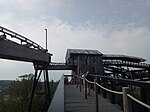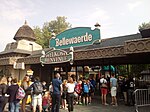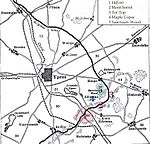Bellewaerde is a theme park in the West Flemish countryside at Zonnebeke near Ypres, Belgium (it is physically located just inside the Ypres municipality boundary). It was established in 1954, on the grounds of the World War I Battle of Bellewaarde. Named after an old castle in its territory that still stands near the main entrance, Bellewaerde is the oldest operating theme park in Belgium. Originally a zoo and safari, the park expanded in the early eighties to become more of a general theme- and thrillpark, catering towards teens and families. The 54-hectare (130-acre) park is known for its beautiful gardens, marvelous landscaping and its attention to theming. Its mascotte is a lion dressed as a king, King Lion. Bellewaerde draws about 850,000 - 900,000 visitors a year and is the main theme park in Flanders.
Major rides include the first Boomerang coaster in Europe (1984), a duelling alpine coaster (Dawson Duel), a Vekoma Mad House (Houdini's Magical House), several water rides including a log flume, a river rapids ride and a spillwater ride, the Screaming Eagle vertical drop tower, various stock rides such as a pirate ship, a swing carousel, an original Zierer beetle coaster, old-timers, carousels, an octopus, tea-cups and a Jungle Cruise-like boat ride, and an entertainment schedule that changes every year. Bellewaerde's additions since 2000 are the world's first Topple Tower from Huss, El Volador (2005), a Zierer indoor coaster, Huracan (2013) a duelling alpine coaster, Dawson Duel (2017), and a Gerstlauer family coaster, Wakala (2020). In June 2019, the park opened the 3000m² Bellewaerde Aquapark, which features a variety of slides, pools, and a lazy river.











